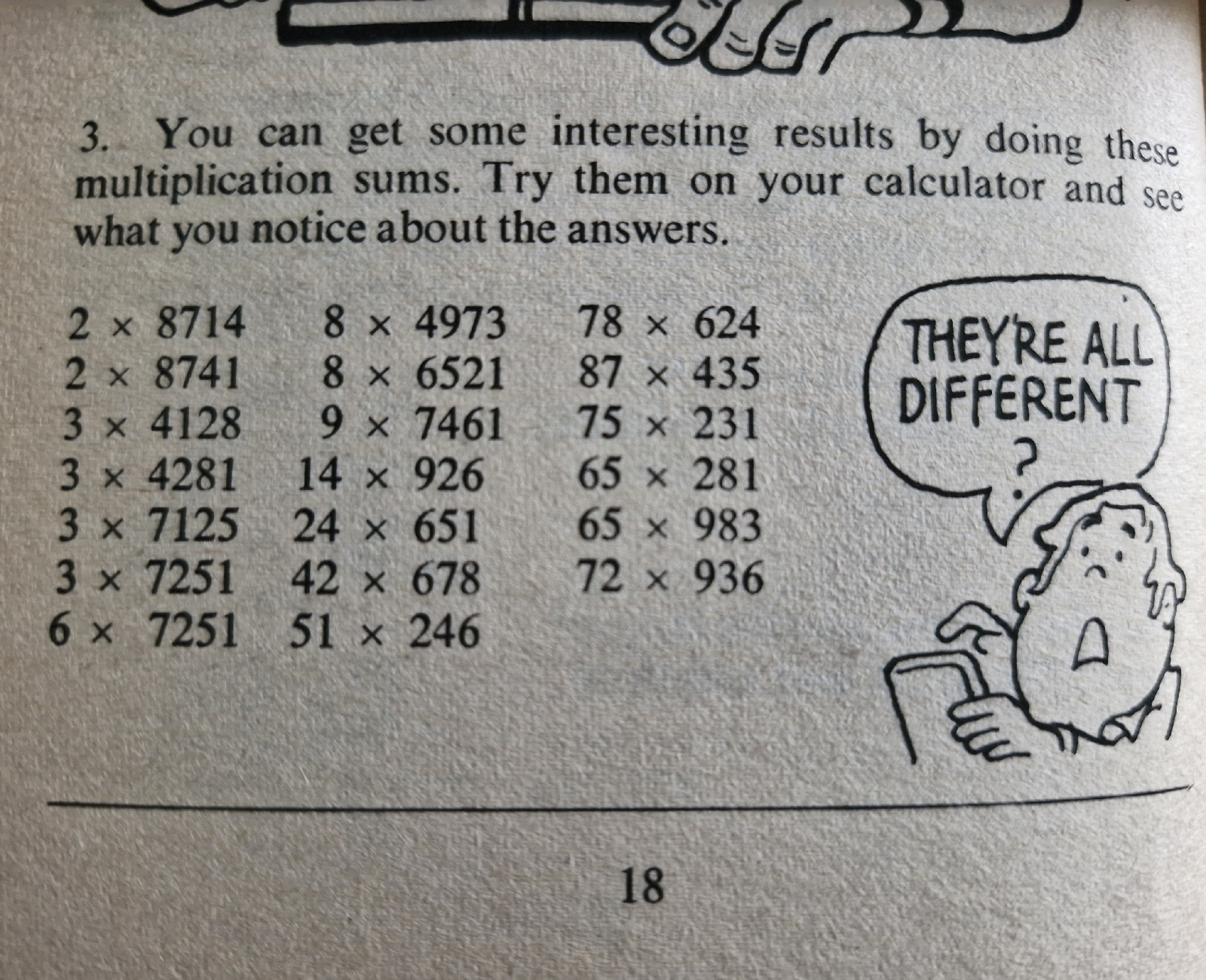This post isn't taken directly from Calculator Fun and Games, but it is definitely a puzzle of the sort that Ben Hamilton could have included in his book. It's very straightforward, and can be demonstrated easily with some examples.
One (or more) players each write down a six- (or seven-, or eight-) digit number on a piece of paper. Using the calculator, they sum the digits and write down the total. They then sum those digits (using the calculator), and repeat until they have a single-digit answer. Largest number wins.Let's try an example: I'll start with 987654 (regular readers will recognise this from my previous blog post on Calculator Fun and Games, called Over and Out).
987654
9 + 8 + 7 + 6 + 5 + 4 = 39
3 + 9 = 12
1 + 2 = 3
My opponent tries a different approach:
123456
1 + 2 + 3 + 4 + 5 + 6 = 21
2 + 1 = 3
So it's a tie.
Time for a tie-breaker: I go completely random and punch six digits into my calculator:
946305
9 + 4 + 6 + 3 + 0 + 5 = 27
2 + 7 = 9
My opponent needs to find something special just to draw this round:
813524
8 + 1 + 3 + 5 + 2 + 4 = 23
2 + 3 = 5
So I win, because 9 is greater than 5.
Analysis
The result for any random number is largely random. You can't identify the final sum-of-digits just by looking at a number, especially for numbers where the first sum of digits is going to be more than 9.
However, there is a definite pattern in the sums of digits of sequences of numbers which is probably not surprising if you think about it (or use a spreadsheet, as I did to analyse some long sequences of numbers).
The second sum - i.e. the final iteration of the summing - follows a very simple pattern: 1-9, then 1-9 over and over again. This extends across hundreds (from 899 to 900) and by the same process, extends across thousands (1999 - 2000) and so on. This means that each digit from 1 to 9 is represented equally as the final sum. The probability of ending up with a 1 or a 7 or an 8 is equal - each digit has a probability of 1/9 of being the final sum.
And providing you don't memorise a number (or a collection of numbers) which sum to a final answer of 9, this makes it an interesting and fun game for young calculator users.
Not that there are many of them around these days! :-)
Note on the spreadsheet:
To break down a three-digit number to its individual digits (which can then be summed), I used these formula. Place the three-digit number in cell A1.
Hundreds:
B1 = INT((A1 - MOD(A1, 100)) / 100)
Takes the remainder of dividing A1 by 100 and subtracts this from A1, then divides this by 100 to provide a digit.
Tens:
C1 = INT((A1 - MOD(A1, 10)) / 10) - 10 * INT(A1 / 100)
Divides A1 by 10 to give a two-digit integer, then subtracts 10 times the hundred digit. The trickiest of the calculations.
Units:
D1 = MOD(A1, 10)
yields the remainder when A1 is divided by 10 - i.e. the units
Further extension: asking an AI bot for a series of maths puzzles that can be solved with a calculator, it replied with this:
Magic Number Game:
Choose a number, multiply it by 9, and then add the digits together until you get a single digit. This digit will always be 9. Try it with different numbers and see if it works.
So: is it true that all multiples of 9 eventually sum to 9?
I have known for a long time that the first sum of multiples of 9 is always 9, and can explain why intuitively, but not comprehensively.
1 * 9 = 9
2 * 9 = 9 + (10 - 1) which means that the tens column is incremented by 1, and the units column is reduce by 1. Therefore the sum of the tens and units will remain unchanged at 9.
9
18
27
36
and so on.
However, this breaks down after reaching 90
9 * 11 = 99
--> 9 + 9 = 18
--> 1 + 8 = 9
...and further iterations of the sums of digits are needed. I've known this as a useful way of determining if a number is a multiple of 9, but I can't prove why it's always the case except by demonstrating it. And my A-level mathematics teacher told me that demonstrating for some cases is hardly a proof for all.
More mathematically advanced brains than mine have already shown why the sums of digits of multiples of nine are always nine - I won't pretend to understand it, but it has been done.
Further reading
Other Calculator Fun and Games articles:
Snakes and Ladders (Collatz Conjecture)Crafty Calculator Calculations (numerical anagrams, five digits)
More Multiplications (numerical anagrams, four digits)
Over and Out (reduce large numbers to zero in as few steps as possible)












